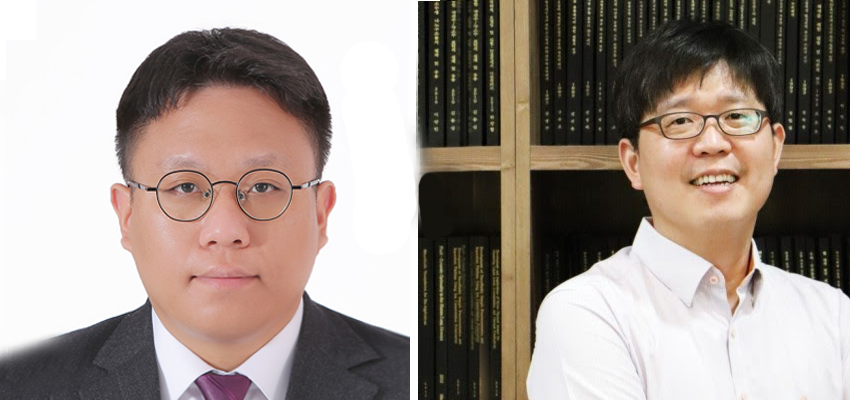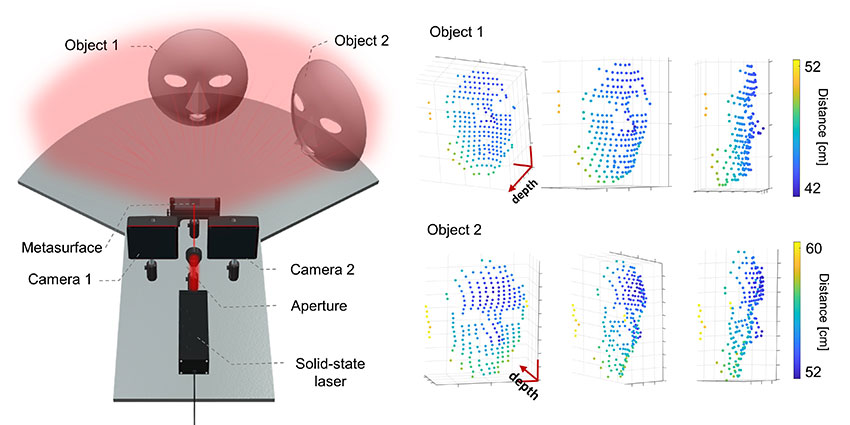Prof. Inki Kim’s Research Team (Department of Biophysics)
Develops an Ultra-small LiDAR Sensor that can See 360 Degrees
- Development of sensor technology capable of recognizing 360 degrees
by spraying 10,000 lights from the front, rear, left, and right
- Ultra-thin meta-surface-based LiDAR sensor, which is only 1/1000th the thickness of hair

▲ (from the left) Prof. Inki Kim (SKKU Department of Biophysics), Prof. Junsuk Rho (POSTECH)
Prof. Kim’s research team (Department of Biophysics) has developed an ultra-compact LiDAR (Light detection and ranging; a device for estimating the location of an object with a laser) that can recognize an object in a 360-degree area with a single measurement.
LiDAR is an abbreviation for Laser imaging, Detection, And Range, which is a technology that measures the distance by measuring the time when reflected light returns by shooting light on an object or surface. By changing the light wavelength and receiving position, the ground surface and the seabed topography can be expressed as a 3-dimensional (3D) image. LiDAR sensors using this technology are recently widely used in autonomous vehicles. The light emitted from the vehicle acts as an eye to help determine the distance or congestion of objects on the road and objects such as vehicles running around the vehicle, and determine the driving speed and direction of driving. With this ability, it has emerged as an icon technology for innovation that leads the autonomous driving technology revolution along with artificial intelligence (AI).
However, the existing LiDAR technology has several limitations. In order to quickly respond to road conditions that change frequently, it is necessary to look not only at the front, but also at the side and rear, but the current sensor is a swivel type, so it cannot detect the front and rear at the same time. In addition, the swivel type LiDAR has a large volume due to various mechanical and electronic components and is very sensitive to external shocks.

▲ A meta-surface-based micro-LiDAR sensor that scatters 10,000 dots everywhere
The research team found a way to manufacture a micro-LiDAR sensor using a meta-surface, an ultra-thin planar optical device that is only 1/1000th of the thickness of a human hair. The meta-surface refers to a 2-dimensional thin film structure made using a pattern smaller than the light wavelength. It also requires less physical space, so it is considered a suitable material for small antenna design. When applied to LiDAR, the viewing angle is greatly increased and objects are recognized in 3-dimensions. The research team succeeded in designing the nano-structure that constitutes the meta-surface and expanding the sensor’s viewing angle to 360 degrees to control the arrangement cycle. When more than 10,000 lights (point clouds) shoot in all directions from the meta-surface are photographed with a camera, an object shape expressed by small dots is visible, and based on this, the object is recognized in 3D.

▲ Experimental results of measuring depth perception of objects. A single measurement can recognize the depth information of objects placed on all sides.
LiDAR sensor technology is also used in ‘Face ID’, a face recognition function of Apple’s iPhone. The iPhone uses a dot projector to form a point cloud, but it has limitations in that the uniformity of dot pattern and the viewing angle are limited and the volume is large. This research is meaningful in that it has realized a technology that recognized 3-dimensional information in the surrounding environment by mobile phones, virtual reality (VR) and augmented reality (AR) glasses, and unmanned robots using nano-optional materials. If nano-printing technology is used, it can be installed on curved objects like glasses or surfaces such as flexible substrates that bend, so it can be applied to AR glasses.
This study was conducted in collaboration with Prof. Junsuk Rho’s research team at POSTECH, with Prof. Inki Kim (Department of Biophysics) participating as the corresponding author. The research results were published online on Oct. 10 (Mon) in the international academic journal Nature Communications (IF 17.694). This study was carried out with the support of the Samsung Future Technology Development Center and the Sejong Science Fellowship Project.
